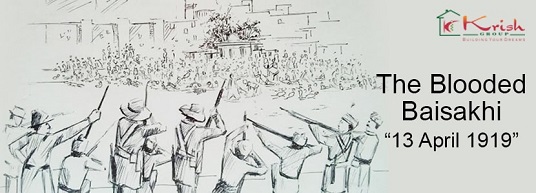The Blooded Baisakhi 13 April 1919

April 13, 1919. The time was 5.30 pm. The sun was going down over Amritsar however it was still very splendid, as it more often than not is in summer in many parts of north India.
At Jaliawala Bagh situated near the Holy place” The Golden Temple” where all the people went to find Peace, a large public meeting had been on for about an hour to protest the arrest and deportation of popular leaders Dr. Satyapal and Dr. Saifuddi n Kichlew. It was Baisakhi so the town was bustling with pilgrims, many of them finding their way to the public meeting, but as the time passes people started coming from different places to attend the meeting as the whole Punjab was about to burst . There was civil unrest everywhere, with crowds stalling trains, uprooting railway tracks, snapping telegraph wires and peoples are in no moods to get calm and it does not matter at which state and at which community they belong as all the people unite to fight and protest against the hideous Rowlatt Act and all the other Acts which were against the humanity.
In the backdrop, the meeting looked like a peaceful protest or self-defence against the cruel decision of arresting the popular leaders and the inhumanity act that were taken by the British Government at that time but the British government and specially General Dyer had different idea as they pretend that meeting same as the revolt of famous 1857 revolt
At 5.30 pm, as the meeting deliberated on the resolutions adopted at a previous meeting the day before, 90 men of the Indian Army under the command of Brigadier General Reginald Dyer marched through the narrow main approach to the Jallianwala Bagh on the double.
There were 65 newly recruited and trained men of the 1/9 Gurkhas, and 25 men collected from the depot of the 54th Sikhs (Frontier Force) and 59 Scinde Rifles (FF). These men were mostly Pathans. Dyer had carefully picked his troops. There were no British soldiers in it, and most of the men were of nationalities deemed foreign to India.
The idea seems to have been to avoid troops who might recoil from acting against Indians. Also, Dyer himself led the troops, breaking convention, and dismissed the senior British company officers of the men. He perhaps wanted to avoid any opposition to his planned action.
The Gurkhas had arrived earlier without their rifles, as their troop train was held up due to the unrest in Punjab. They were issued fresh rifles from the armory. Altogether, only 50 men were armed with the Short Magazine Lee Enfield Mark III, .303 rifle; 40 Gurkhas just had their kukris. There were two armored cars with a machine gun on top each, but these had to be parked outside as the passage was too narrow. After that what happened we all know, 100’s of people were murdered at the command of that inhuman man and the whole place turned into the “cemetery” from the place where all the people peacefully protesting against the decision and enjoy the Baisakhi Festival by wishing each other.













